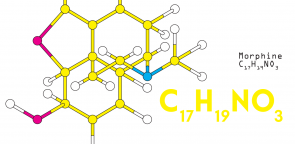
Out of all drugs, the perception of morphine has swung the most between either extreme.
Its image is cyclical, at times glorified, while at others, demonised. The molecule’s existence has been a chaotic one since its discovery in the early 19th century. But the poppy, the plant from which morphine is derived, has been used by humans for thousands of years. “We’ve always known that ingesting opiates was dangerous and could result in addiction,” says Thierry Buclin, chief of the Clinical Pharmacology Service at the Lausanne University Hospital. “We thought we finally had the solution with the development of the modern syringe in the 1850s, which would replace oral administration.” At the time, surgery was spreading fast with the invention of anaesthesia. Doctors no longer operated only in desperate cases,
as patients howled in pain. More delicate operations could be performed on a patient who was peacefully sleeping and who would be given an appropriate pain killer once he woke up. The product is powerful, easy to transport and rapidly showed up on battlefields.
But the issue of addiction did not go away. It was even aggravated by the use of injections. There were endless stories of addicted patients and health care staff who would steal supplies for their personal consumption. The situation worsened to the point where an active campaign to restrict and control narcotics was launched during World War I.
“The crisis might also be explained by the moral attitudes of the period, along with the tragic negligence towards patients’ suffering,” says Thierry Buclin. “I remember when I was a student, decades later, morphine still had an image surrounded by an aura of death, reserved only for lost cases.”
This trend was reversed in the 1960s with the activism of pain relief pioneers such as Cicely Saunders, a nurse at the time, who was shocked by the fate of her patients forced to live with their pain. She led a lifelong battle, which turned her into an internationally recognised figure. She is most famous for setting up the first modern hospice centre in the United Kingdom. “It was the beginning of the global awareness of the suffering experienced by patients in hospital,” says Thierry Buclin. “A number of books were written on the subject (namely “Anthropologie de la douleur” (“Anthropology of Pain”) by David Le Breton) and transformed the way pain management was taught to professionals, promoting pain prevention and using plenty of morphine.”
Nearly 150 years after its arrival, morphine remains irreplaceable. “But that’s not the whole story,” says Thierry Buclin. “While pain relief remains very inadequate in developing countries, the consumption of opiates is increasing considerably in industrialised regions, and overdoses, abuses and even deaths are back on the rise.” Might attitudes begin to swing back in the other direction?